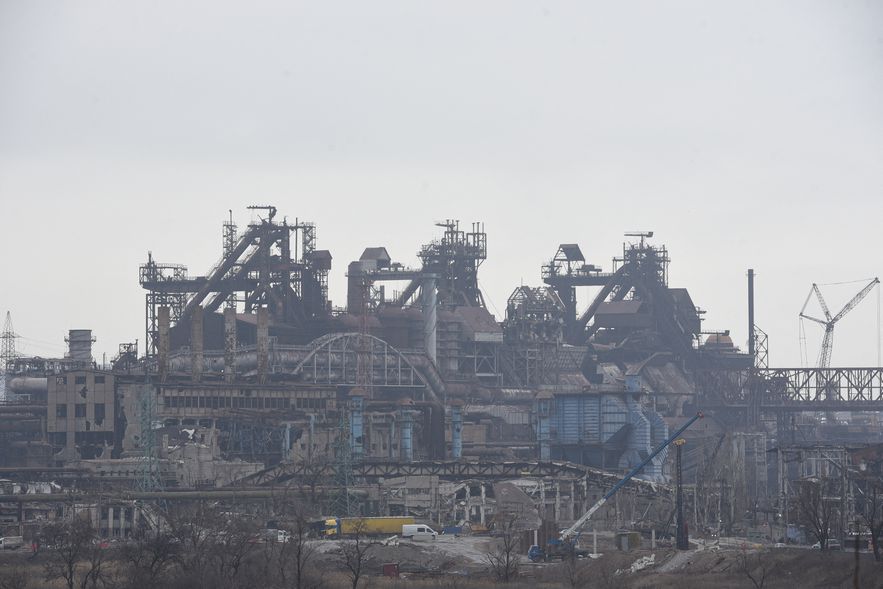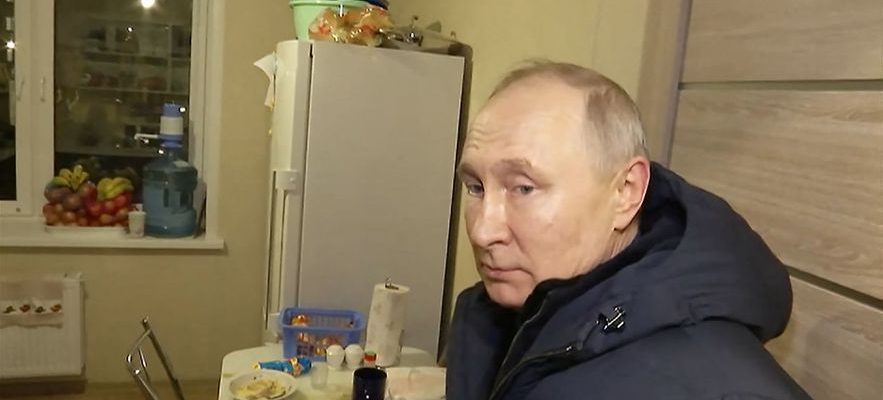“Thank you, Vladimir Vladimirovich!” In her brand new apartment, Lydia, a bubbly septuagenarian, does not hide her joy. A year ago, in the midst of the siege of Mariupol by the Russian army, this former professor had decided to take refuge in Russia with her husband, a former foreman of the Azovstal metallurgical plant. After they left, their building, targeted by a tank, had burned down. The couple lost everything, but Russia offered them a new home.
Prepared, flirtatious, the retiree is a fan of Vladimir Putin, whom she describes as a “defender”. “We believe him, he is doing nothing wrong! she assures us. Look at kyiv, nothing was destroyed, whereas in Mariupol, did you see what the Ukrainians did?” Convinced by Russian television, she believes that Ukraine destroyed her town and that Russia saved her from future persecution. She is convinced that the Ukrainians wanted to prevent her from speaking Russian. Didn’t the kyiv government decide, in 2014, that Pushkin’s language was no longer an official idiom? At the time, the Russian state channels, which were already preparing the ground for an armed intervention by the Kremlin, had presented this measure as a threat to the inhabitants of Donbass.
Misinformation runs rampant
In Mariupol, where, after months without electricity, the Russian media are the only accessible ones, the intense disinformation has succeeded, among some inhabitants still in shock, in placing the responsibility for the destruction of the city on the Ukrainians.
With a little overplayed enthusiasm, Lydia almost comes to congratulate herself on the damage suffered by her city, which has allowed the construction of new buildings “white as clean” and the promise of a “greener” city. The Kremlin wants to make Mariupol a seaside resort.
Created on the outskirts of the city, a “witness district” has emerged from the ground. It was baptized Nevski, in homage to the Russian national hero, whose burial rests in Saint-Petersburg. The birthplace of Vladimir Putin has been twinned with Mariupol, which commits him to finance a large part of the reconstruction. In reality, Nevski is the first stage of a gigantic project to erase the traces of the war, organized in the same way as the reconstruction of the city of Grozny after the war in Chechnya.
Its buildings resembling a Potemkin village, which contrast with a city blackened and ravaged by fires, have been built in a hurry, in recent months, by a company linked to the Ministry of Defense. Hazardous finishes, absence of elevators… Mostly empty, these buildings are suspected of being at the heart of a gigantic scheme of corruption by the investigators who collaborate with the opponent Alexeï Navalny. They are delivered without furniture and without a title deed with a small envelope of 100,000 rubles (about 1,100 euros). Vladimir Putin visited this district during a discreet trip, in the middle of the night, according to images posted online by his press service on March 19. While neighbors of Lydia thanked the Russian president for these new apartments, a woman shouted from her window: “It’s all fake! It’s for show!”, reminding that the whole city is not satisfied of the arrival of the Russians.
A still from video released by the official Russian press service on March 19, 2023, showing Vladimir Putin visiting a newly constructed apartment building in Mariupol.
/ © HANDOUT / RUSSIAN PRESIDENTIAL PRESS OFFICE / AFP
That evening, Lydia understood that something was happening. “I saw the cars and the helicopters, then I saw him on TV, he was handsome…”, she said of her “defender”, Putin. Trapped in her fantasized image of Russia, the retiree finds it hard to believe, in a good sense full of naivety, that it is forbidden to oppose war. “It’s impossible! It’s a lie to say that people who have expressed their opposition are being persecuted. So Russia wants war?”
Ruins and desolation
Near her home, a pile of burnt-out cars lies in the rubble of a shopping center. On the shores of the Sea of Azov, the arrival of the Russian world so awaited by Lydia caused thousands of victims.
The three metallurgical factories of the city, which were the main employers of the city, are out of order. The famous Azovstal factory is nothing more than a tangle of metal and concrete. A year later, the authorities are still clearing the site while 4,500 men are working to cut the metal. The eastern part of the city is totally destroyed, like the historic center and the residential areas, located near the port. There is no longer a living soul, all is ruins and desolation. In the stairwells, inscriptions for rescuers and marauders – “Here, living inhabitants” – can still be read on the doors of the apartments.

The famous Azovstal factory, in Mariupol, on March 16, 2023.
© / STRINGER / ANADOLU AGENCY / AFP
It is near the port that Natalia and Vitali, a couple in their forties, had built the house of their lives. “A two-story building with a view of the Sea of Azov,” recalls the young woman. “One morning the fighting started. We found ourselves between the two sides. There were bombers, artillery on all sides, it was frightening. Every morning the fighting resumed at 4 o’clock,” says the former entrepreneur, still in shock. For a month, the couple lived in their basement with about fifteen neighbors. “The temperature went down to -10 degrees, we wanted adrenaline. Electricity, then water and gas, were cut off, a shot hit the roof of the house. We decided to leave “, she continues, in a cold anger. “We lived in Ukraine, the city was beautiful, it was developing, there were tourists. Then Russia came, now we are under occupation.”
Everywhere in town, Russian or Central Asian workers are busy at the foot of buildings and on rooftops. Their mission is to restore the gas in all the homes, change the windows and repair the apartments damaged by the shootings. These “hidden workers” are omnipresent, much more than the “real” inhabitants, whose number is unknown. Nikolai, a young engineer from Perm, in the Urals, returns from his construction site, drunk. “I get paid 5,000 rubles a day [environ 56 euros] to work on the construction site of a hospital”, he said, before adding: “Our guys are dying in combat. We don’t want war either. Some locals don’t like Russians, they are hostile. But we came in peace, to rebuild.”
A stone’s throw away are the ruins of the theatre. On March 16, 2022, a Russian bomber dropped its bombs on this building which would have housed a thousand civilians. A year later, the final toll is still unknown: the Ukrainian authorities estimate it at 400 dead, Amnesty International has only been able to confirm a dozen.
Accused of a war crime, Russia hastened to destroy the building. Former resident of this disappeared district, Tatiana is still traumatized. For two months, she survived in a cellar with neighbors. “We were risking our lives to get water and food. One day, a Ukrainian sniper took up residence on the roof of our building. He asked us not to go out, everything was mined. He ended up by being killed.” Fragile, the lady remembers that at least “300 people were buried behind the theater”, in a period when the victims were buried at the foot of the buildings. They were then moved to a cemetery, while a park and a fountain were built in place of these ephemeral tombs. Tatiana has also accepted an apartment in the Nevsky housing estate. But she worries and lives discreetly in her empty two-room apartment, protected by dozens of icons. She fears partisans, whom she says are “present in town”, or Ukrainian fire, which could attack her building, which has become symbolic since Vladimir Putin’s visit. In Mariupol, all the survivors live between two wars, waiting for a Ukrainian counter-offensive feared by some, awaited by others.
